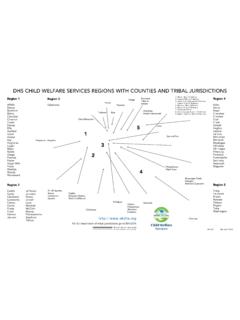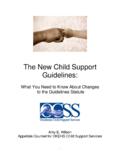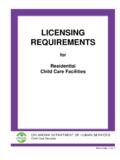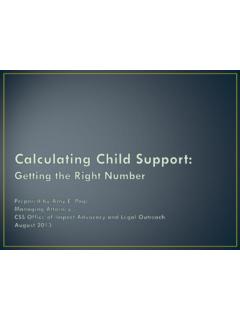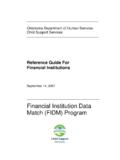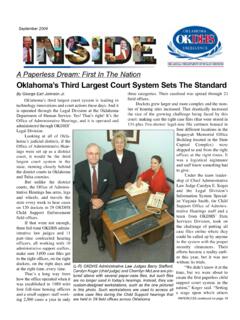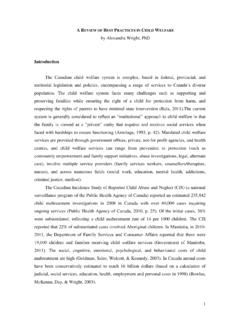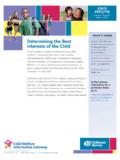Transcription of Strategic Plan SFY 2017-2018 Child Welfare Services
1 Strategic PlanSFY 2017-2018 DHS STRATEGY MAPSFY 2017-2018 OUR MISSIONWe improve the quality of life of vulnerable Oklahomans by increasing people s ability to lead safer, healthier, more independent and productive VISIONDHS provides help and offers hope to vulnerable Oklahomans through stronger practices, involved communities and a caring and engaged VALUESS afety Integrity Professionalism CompassionSTRONGERO klahomansWe help Oklahomans who are vulnerable lead safer, healthier, more independent and productive lives. We will: Improve the well-being of the people we serve Improve access to our Services and benefitsSTRONGERW orkforceOur workforce is informed, supported and will: Promote safe, healthy work environments Improve the effectiveness of our workforce Continue to improve employee engagementSTRONGERC ommunitiesWe are engaged with communities to meet the needs of Oklahomans who are will: Build and strengthen community partnerships Help Oklahomans who are vulnerable access community resourcesSTRONGERP racticesWe have a culture of continuous will.
2 Continue to improve the department s effectiveness, efficiency and accountability Continue to evaluate the impact our Services and benefits have on Oklahomans who are vulnerableFigure 1. SFY 2017-2018 Strategy MapCWS Strategic Plan | Page 1 DHS STRATEGY MAPSFY 2017-2018A Letter from the Director of Child Welfare ServicesCourageous actions aimed at moving Oklahoma s Child Welfare system forward have occurred in the recent months and years. With the support of the Oklahoma Legislature and the community, tremendous progress in several key areas has been made. More of Oklahoma s children are being safely maintained in their homes, more children are exiting the system to permanency, and more children who require out-of-home placement are placed in foster homes as opposed to congregate care settings.
3 The Pinnacle Plan established the direction, expectations and values from which the workforce will operate, resulting in more empowered families and a more empowered agency that knows where it s going and primary driver behind all of the change is the value we hold as a division and as a state that every Child in Oklahoma deserves a safe, stable family every day. This value is represented throughout all of our work with families. Safety is our priority and at the center of all of our decisions. We as a Child Welfare system strive for children to be maintained in their own homes whenever that is safely possible. When that is not possible, we work to place children with relatives first. If a relative placement is not possible, we seek to place children with foster families.
4 It is our goal for every Child who enters our system to be appropriately matched to a family who can care for their unique needs until such time that the Child can return home. We seek to recruit foster families who understand that supporting children in foster care involves wrapping supports around the biological families so that, ultimately, reunification can be successful. When reunification is not possible, we seek to achieve permanency for children through adoption or guardianship in a timely key Pinnacle Plan commitment established four years ago focuses on community engagement. DHS cannot do it alone. Effective partnerships are necessary for DHS to fulfill its responsibilities related to Child safety, permanency and well-being.
5 Over the last four years, a heavy focus has been on strengthening existing partnerships while simultaneously creating new ones. We have also watched our state begin to transform from primarily a single-state agency responsible for meeting the needs of children and families in the Child Welfare system to a collaborative approach with a multitude of public and private partners working together to effectively serve our children and their families. We will continue to operate in a manner that exemplifies continuous quality improvement, working to create long-term sustainable change within our system so that every Child in Oklahoma has a safe, stable family every day. I look forward to experiencing more growth within our system, within our workforce, and, most importantly, within our communities.
6 CWS Strategic Plan | Page 2 DIVISION OVERVIEWC hild Welfare Services (CWS) is the DHS division responsible for administering the state s Child Welfare Services . The DHS mission is to improve the quality of life of vulnerable Oklahomans by increasing people s ability to lead safer, healthier, more independent and productive lives. The purpose of Child Welfare Services is to improve the safety, permanence and well-being of children and families involved in the Child Welfare system through collaboration with families and their communities. CWS is committed to: Equity where all children, youth and families have access to and receive unbiased treatment and Services Keeping children safe with their families through prevention Services , kinship placements and timely reunification, whenever possible Ensuring every Child is safe while in out-of-home care and custody by recruiting, retaining and supporting resource families that best match the needs of the children and can provide for their safety, permanency and well-being Moving to a continuum of care that best meets the needs of children in out-of-home care and provides for the least restrictive family-like placements, except in extraordinary circumstances Recruiting.
7 Retaining and supporting the best Child Welfare staff through a commitment to ongoing staff development and ensuring manageable caseloads and workloads Engaging local communities and agency partners in improving Child Welfare outcomes CWS cannot do it alone Child Welfare Practice Standards serve as the guiding principles for all work within CWS. Our Practice Standards continually examine the use (misuse) of power, use of self and personal respect and honor the families we listen to the voice of continuously seek to learn who families are and what they believe in the value of Nothing About Us Without Us maintain a Child s permanent connection to kin, culture and conduct our work with integrity at all levels of CWSThe Child Welfare Executive Team, comprised of the nine deputy directors and the Child Welfare director, leads the state Child Welfare team.
8 There is a deputy director for each of the state s five regions, each providing Child Protective Services , Family-Centered Services , and Permanency Planning Services . Reporting to the five regional deputy directors, and covering 27 state districts, aligned according to district attorneys responsibilities, there are 47 district directors. To support the critical work in the five regions, four teams, each led by a deputy director, are responsible for Bridge, Programs, Quality Assurance and Staff Development, and Child Welfare Partnerships. CWS Strategic Plan | Page 3 The Bridge Team is responsible for the policy, procedures and programs for Adoptions and Post Adoptions, which involves assisting in securing a safe, permanent home for children in DHS permanent custody through a comprehensive array of Services that identifies, approves, matches and supports adoptive families.
9 The Post Adoption Services Section is responsible for administering financial and medical benefits, Child care, Interstate Compact on Adoption and Medical Assistance (ICAMA), Confidential and Intermediary Search, Reunion and Paternity Registries, and providing case management service to all who finalized an adoption of a Child who was in out-of-home placement. This team is also responsible for Foster Care, including the recruitment, retention and training of resource families. Finally, the Bridge Team is responsible for ensuring protection and Services to children who are placed across state Programs Team is responsible for policy, procedures and programs. This team also includes the DHS Centralized Abuse and Neglect Hotline director and the program supervisor for policy.
10 This team handles Child Protective Services , Family-Centered Services , Oklahoma Children s Services , Appeals, and Child Abuse and Neglect Information System inquiries, Permanency Planning Services , Independent Living Services , Developmental Disabilities and Education related Services , and Trauma-Informed Care Services . The Programs Team is also responsible for residential placements and therapeutic foster care, and tribal partnerships. The Quality Assurance and Staff Development teams are responsible for the DHS KIDS database management, including system development and maintenance, SACWIS compliance, KIDS Helpdesk, KIDS application training, and management reports. Additionally, they handle the development of CWS training programs, as well as the training of the CWS staff, Quality Assurance and the Child and Family Services Reviews.
